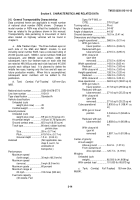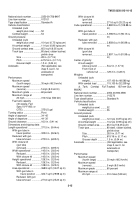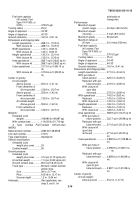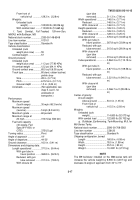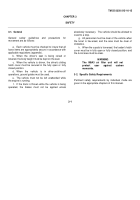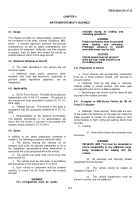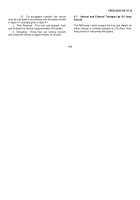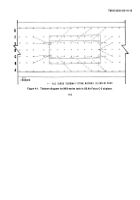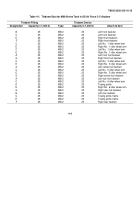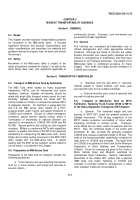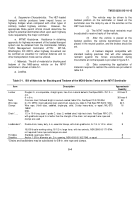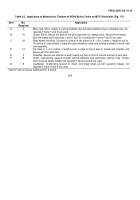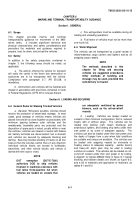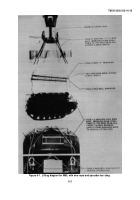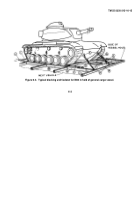TM-55-2350-215-10-15 - Page 28 of 66
TM 55-2350-215-10-15
CHAPTER 5
HIGHWAY TRANSPORTABILITY GUIDANCE
Section I.
GENERAL
5-1.
Scope
This chapter provides highway transportability guidance
for movement of the M60-series tanks.
It includes
significant technical and physical characteristics and
safety considerations and prescribes the materials and
guidance required to prepare, load, tie down, and unload
the vehicles.
5-2.
Safety
Movement of the M60-series tanks is subject to the
safety precautions contained in chapter 3, as well as the
same safety laws, rules, and regulations applicable to
commercial carriers.
Overseas, such movements are
governed by theater regulations.
5-3.
General
The vehicles are considered self-deliverable only in
limited emergencies and under appropriate tactical
situations.
Although the tracks of vehicles are rubber
bushed, movement over paved public highways will be
limited to contingencies or mobilization and must have
approval of civil highway authorities.
The weight of the
M60-series tanks is considered excessive for many
bridges.
Their width and height exceed limitations in
CONUS and overseas.
Section II.
TRANSPORT BY SEMITRAILER
5-4.
Transport of M60-Series Tank by Semitrailer
The M60 Tank, when loaded on heavy equipment
transporters (HETs), can be transported over public
highways; however, highway movements should be
made only when other transport modes cannot be used.
Normally, highway movements are made with the
vehicle loaded on military or commercial low-bed HETs
of adequate capacity.
As identified in paragraphs 5-5
and 5-6, the M60 series, when loaded on a HET,
exceeds length, width, height, and weight limitations in
CONUS and overseas.
Except for certain emergency
conditions, special permits, special routing, and/or a
"certification of essentiality to national defense" are
required for movements in CONUS (AR 55-80 and AR
55-162).
Special permits and routing are also required
overseas.
Military or commercial HETs with capabilities
equal to or greater than those of the M747 are generally
satisfactory for transporting the M60-series tank.
Some
States will not allow routine movement of the M747 HET
when loaded with the M60-series tank.
A typical
loading, with the M747 as the transport vehicle towed by
a truck tractor, is contained in this chapter.
5-5.
Preparation of M60-Series Tank
Preparation of the M60 tank for transport includes the
following procedures:
a
.
Turret traverse and gun-elevating mechanism
must be in travel position and locked and wire-tied to
prevent rotation.
b
.
Antennae must be tied down or removed,
hatches placed in closed position, and loose gear
secured with nylon cord or suitable substitute.
c
.
External machine guns must be removed and
secured in locations provided.
5-6.
Transport of M60-Series Tank on M747
Semitrailer, Towed by Truck Tractor (M746 or M911)
of the Heavy Equipment Transporter (HET) System
a.
General
.
The combined weight and axle
spacing of M747 HET poses the greatest problem to
highway movement.
The air-bag suspension of the
M747 causes excessive overloading of axles when
traversing horizontal or vertical curves.
Therefore,
some States will not allow routine movements with the
M747.
Also, the combined length of the tractor and
semitrailer, 61 feet, exceeds the generally accepted
CONUS and oversea unrestricted length of 55 feet.
The
width of the tractor/semitrailer combination exceeds the
legal limits for CONUS and overseas.
The legal limits
for CONUS are published in chart form by the American
Association of State Highway and Transportation
Officials.
Those for overseas are given in the Limits of
Motor Vehicle Sizes and Weights, published by
International Road Federation, Geneva, Switzerland.
Movement of the loaded HET system with a payload
(M60 tank) over public highways in CONUS and
overseas is normally limited to emergencies or when
other transport modes are not available or
5-1
Back to Top

